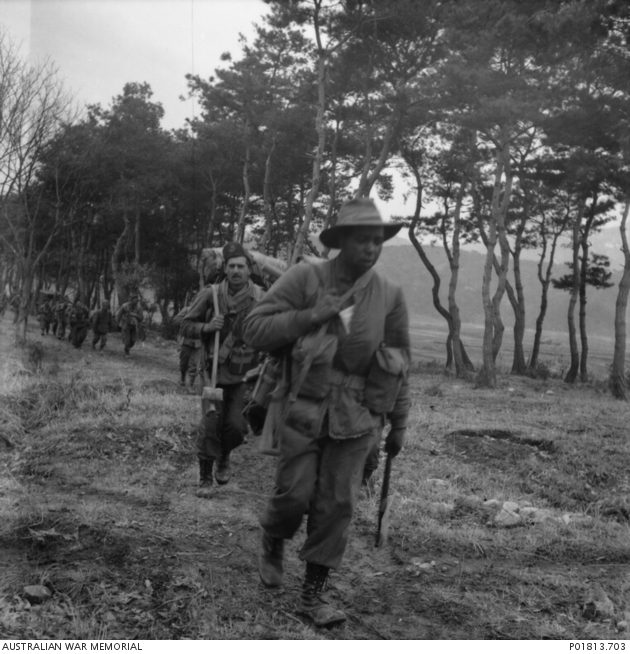Reg Saunders
Saunders with Lieutenant Tom Derrick VC DCM on their graduation day, c. 1944.
Reginald Saunders was born near Purnim, Victoria, on the Framlingham Aboriginal Reserve in 1920. Reg, as he was known, was named in honour of his uncle, William Reginald Rawlings, who had earned a Military Medal for his bravery in the First World War. Reg’s father, Chris, had also served in the First World War; however, while he survived, Rawlings was killed in action in August 1918.
Raised by their grandmother after their mother died in 1924, Saunders and his younger brother, Harry, remained close to their father, and the three later opened a sawmilling business together. When his father talked about the First World War, Saunders listened with “ears as big as footballs”, and at the outbreak of the Second World War he was eager to volunteer for service.
Indigenous Australians were prevented from enlisting in the Second Australian Imperial Force (AIF), but restrictions were not consistently enforced and both Saunders brothers joined in early 1940. Reg Saunders soon proved to be a natural soldier and an outstanding leader, and was promoted to sergeant within a few short months.
After perilous encounters with German aircraft in North Africa and Greece, Saunders' battalion took part in the ill-fated campaign on Crete. Britain had established a garrison on this strategically important island in late 1940, but few preparations had been made for its defence by the time the German conquest of Greece in April 1941 placed it under threat. By the end of the following month the Allies were forced to evacuate, but there was neither enough time nor ships to transport them, and hundreds, including Saunders, were left behind.
Saunders remained hidden on the island for the next 11 months, helped by a local family. He finally escaped aboard a British submarine and returned to Australia, where he began training for jungle warfare against the Japanese in the Pacific. In late 1942 Saunders learned that his younger brother, Harry, had been killed in the bitter fighting that had taken place towards the end of the Kokoda campaign.
Saunders was in New Guinea the following year, where he was soon selected for officer training back home in Australia. Graduating as a lieutenant, he returned to New Guinea commanding a platoon of 30 men.
The feeling of equality many Indigenous Australians had experienced in the army disappeared when the Second World War ended. Saunders moved to Melbourne with his wife, Dorothy, and three young children, but struggled to find work that matched his skills and qualifications.
He re-enlisted for service in the Korean War, in which he led a company of 100 men. In April 1951 his unit helped bring the rapidly moving Chinese and North Korean forces to a temporary halt, which earned them the United States Presidential Distinguished Unit Citation for “extraordinary heroism and outstanding performance”.
Saunders was discharged from the army at the end of the Korean War and later moved to Canberra, where he worked at the Department of Aboriginal Affairs. He was made a Member of the British Empire for his commitment to raising the profile of Indigenous communities and was appointed to the Council of the Australian War Memorial. He died in 1991, aged 69.
Activities for research and classroom discussion
- Saunders’ father, Chris, was 21 years old when he volunteered for service in the Australian Imperial Force. He arrived on the Western Front in late 1916, and returned home to Australia more than two years later. How do you think Saunders’ father may have felt about his sons both volunteering for service?
- Listen to the following oral history recording [number 6, tape 1, side 1] or download the transcript. Why did Saunders volunteer for service? What expectations do you think he may have had about army life prior to enlisting?
- Saunders’ brother was killed in the bitter fighting that took place towards the end of the Kokoda campaign. How has Hodgkinson portrayed the conditions experienced by Australian troops on the Kokoda Trail?
- Created by Dean Colls and Louise Skacej, this diorama captures the experiences of one group of Australian soldiers during the battle of Kapyong. What kinds of sources do you think the artists drew upon to create this diorama? Do you think this diorama is an accurate portrayal of events? Why or why not?
After he graduated as an officer, Saunders received a letter of congratulations from Reverend Gordon Rowe, secretary of the Aborigines’ Friends Association in Adelaide. In his reply, Saunders wrote:
My philosophy is that once a person undertakes to do something, no matter how big or small, that person should do it to the best of his or her ability … You mentioned in your letter an attitude towards people of my race. I am sorry, but neither you nor I can change that attitude, because the changing of it rests with the Aborigines themselves, and my contribution towards helping them is just simply by setting myself up as an example – not by words, which are cheap, but by deeds.
What does this extract tell you about the type of person Saunders was? How might Saunders have been an example to other Aboriginal and Torres Strait Islanders?
Return to Memorial Box 3 supporting resources



